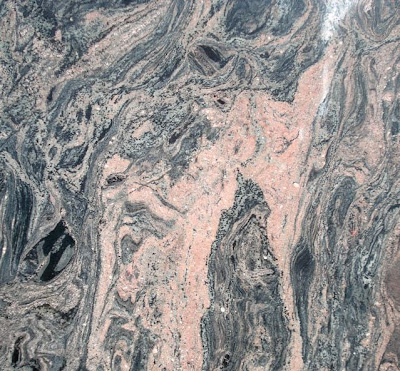
Tag: morton gneiss
The Most Beautiful Building Stone in the Country

Rectangular, two stories tall, and clad partially in brick, the Morton liquor store has a practical appearance, though it does incorporate some semblance of an aesthetic with the cornice and frieze. They have a pattern of outlined squares atop two, horizontal rows of raised bricks, which rest on another row of inverted, stepped pyramids. A faded red awning adds another touch of character, boldly proclaiming in large white letters, MORTON LIQUOR.
The gneiss starts below the cornice. Pink and black layers swirl around each other as if they are still fluid. Other layers look stretched and torn like taffy. Four inch-wide eyes of black minerals, complete with white eyebrows, dot the variegated layers. I cannot imagine trying to contemplate this wall of stone after spending a few hours partaking of the goods sold within.
Known in the trade as Rainbow Granite, the stone has been quarried in Morton since 1884. Cold Spring Granite has longed owned the quarry, which is opened on a limited basis. Because of the stone’s unusual color and patterns, it was a popular building material during the 1920s and 1930s, when Art Deco architecture was all the rage.

The Qwest Building in Minneapolis, originally the Northwestern Bell Telephone Building, built 1930-1932
Morton clad structures can be found around the country. The tallest is in New York, the 952-foot high AIG building (formerly Cities Service). The most northern is in Seattle, the Seattle Exchange Building. The closest to John Wayne’s birthplace in Winterset, Iowa, is in Des Moines, the Bankers Life Insurance Building. The most recently converted to lofts is in Birmingham, Alabama, the Watts Building.

Up close with the Morton Gneiss
Geologists had long known that the Morton Gneiss was very old but not until 1956 when Samuel Goldich and three other geologists published a crystallization date of 2.4 billion years did geologists learn how old. Previously, geologists had simply used undated terms such as primitive, Huronian, and Archean. Seven years after Goldich’s discovery, Ed Catanzaro pushed the date back to 3.2 billion years, the oldest age so far determined on this continent. Not to be outdone, Goldich reanalyzed the Morton and came up with a date of 3.55 billion years. In November 1974, the rock became even older when Goldich reported the Morton was 3.8 billion years old, not just the oldest rocks on North America but the oldest rocks on Earth. As one can imagine there was much rejoicing.

The Morton Gneiss Quarry, in Morton
Fame was fleeting though. By 1980, the age of the Morton had dropped back to 3.5 billion years. In 2006, Pat Bickford, emeritus professor of petrology at Syracuse University, led a team of researchers who obtained the Morton’s most up to date age of 3,524 million years. Although the Morton is but a babe compared to the oldest rocks on Earth, it is still the oldest, most commonly used building stone in the world. And, in my opinion, one of the best looking.
